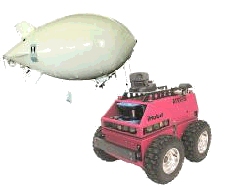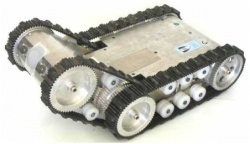Field Robotics
Introduction
ISLab has been developing, together with the Mobile Robotics Lab, and under the Theme B of ISR - Associate Lab, field robotics activities and applications, motivated by their novel scientific and technical challenges (such as the cooperation among land and aerial robots, and among robots and humans, in unstructured, frequently outdoors, scenarios), relevance for public policies, and potential for innovative results on unstructured environments blending sound theory and technological developments. The work has been driven so far by applications to search and rescue, as well as urban, scenarios.
Research activities
Initial work in field robotics comprised Search and Rescue (SAR) scenarios as a unifying testbed for diverse research approaches, ranging from the construction of new platforms, up to high-level coordination of mixed initiative human/robot teams. This sections enumerates these activities in a chronological sequence.

This project aimed at endowing a team of outdoors robots with cooperative navigation capabilities, so as to demonstrate the ability of the robots to act individually and cooperatively in search and rescue-like operation scenarios. Search and Rescue (SAR) operations are a challenging application for Robotics since, due to their nature, they naturally foster advances in Artificial Vision, Navigation in outdoors unstructured environments, Distributed Artificial Intelligence and Intelligent Control.
The long-term objectives of the project consist of applications to SAR under large-scale catastrophe scenarios, namely after an earthquake. However, the current proposal is focused on the first steps towards the long-term goal and, as such, it refers to simpler scenarios and is based on some simplifying hypotheses, such as daylight operation and pre-planned robotic tasks. Also, the robotic team will include only 2 robots, purposively made heterogeneous, both regarding the functional, hardware and software architectures: one wheeled and one aerial robot. Therefore, each type of robot can be assigned tasks with different requirements under SAR operations.
The following is a list of problems that will be addressed and, at least partially, solved during the current project:
- Definition of a functional architecture suitable for the integration of the subsystems composing the robotic team, oriented towards SAR applications.
- Choice of the appropriate sensors and sensor fusion methodologies.
- Issues concerning topological, world-model-based and sensor-based navigation within unstructured environments, as well as their extension to cooperative navigation, where 2 robots communicate with each other to share information relevant for team navigation improvement.
- Task coordination, including the appropriate integration of the functional subsystems and resources management during the execution of a given robotic task.
This project was funded by the Fundação para a Ciência e a Tecnologia (FCT) under the contract SRI/32546/99-00.
Project link: http://rescue.isr.ist.utl.pt
Localization and Map Building

In the context of the Rescue project previously referred, research on localization and map building using a land vehicle was carried out. In particular, SLAM techniques were used to build a topological map, as well as navigating along such a map. Topological maps differ from traditional metric maps in the fact that they represent topological relations among landmarks, rather than their exact coordinate position. Maps of urban subways are a classic example of such a map, as for traveling in a subway, the geographical relative positioning among stations is irrelevant. In the case of a SAR robot, cooperating with human teams, it is in general more efficient to communicate using landmark positions, instead of geographical coordinates.
Further details: http://lrm.isr.ist.utl.pt/rescue
RAPOSA robot

The RAPOSA robot is a tracked wheel robot build in cooperation with the Portuguese company IDMind, a ISR spinoff, together with the Lisbon firefighters corporation. This project comprised the design and construction of a tracked wheels robot, for the use in SAR operations. The input that the Lisbon firefighters provided was essential for the specification of the platform.
This project was funded by the Agência da Inovação (AdI).
Original project link: http://raposa.idmind.pt (hosted at IDMind since they were the consortium leaders)
Currently, active research is being carried out using this platform, namely in the following issues:
- autonomous docking to the cable (this robot is capable of attaching a cable providing power and a wireless link access point; is cable is also strong enough to lift the robot up)
- autonomous stair climbing as this robot was mechanically designed to be able to climb standard stairs; here a control algorithm is capable of driving the robot straight up along a staircase
- 3D remote operation using a Head Mounted Display (HMD) using the camera pairs to feed stereo video, and thus providing the operator with depth perception of the environment the robot is located in
Further details: RAPOSA robot